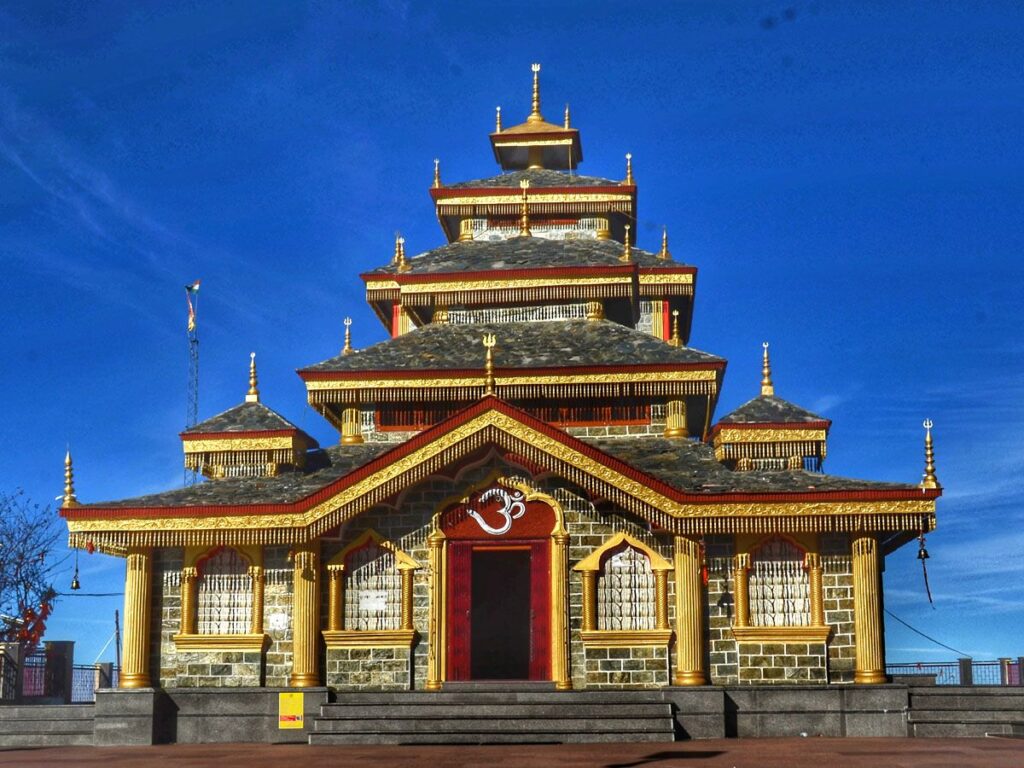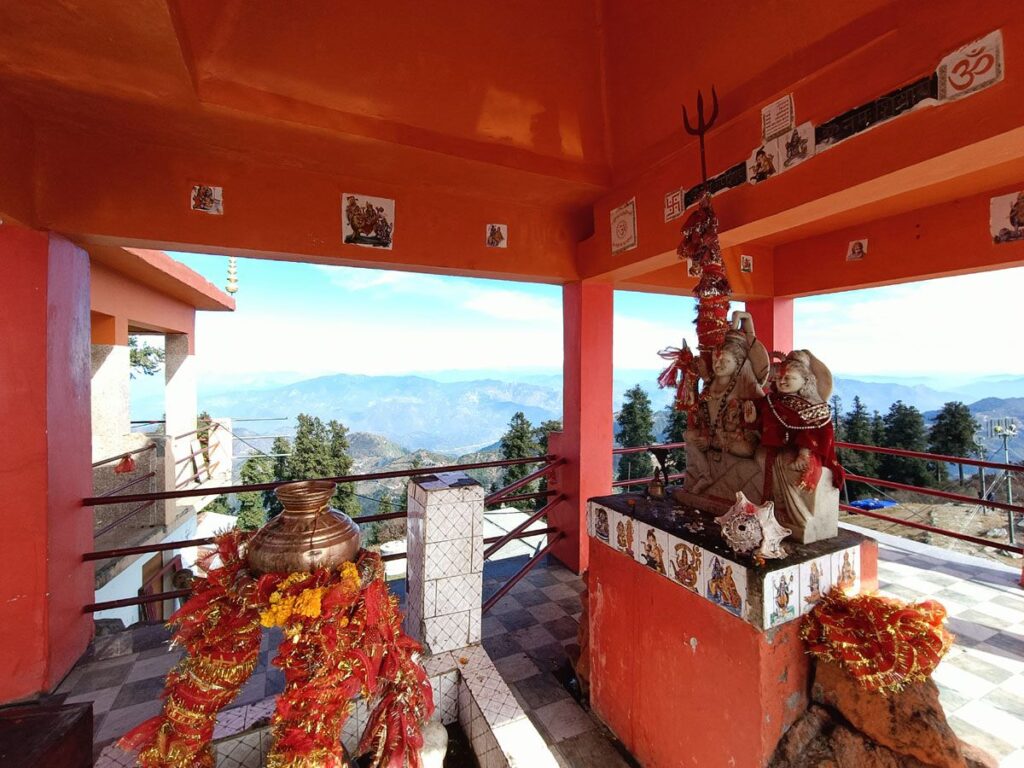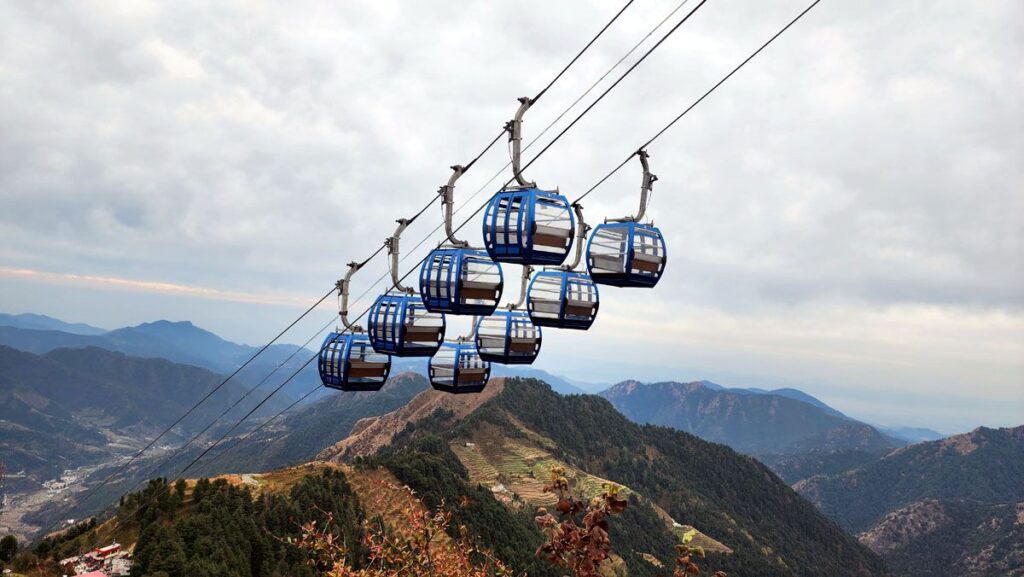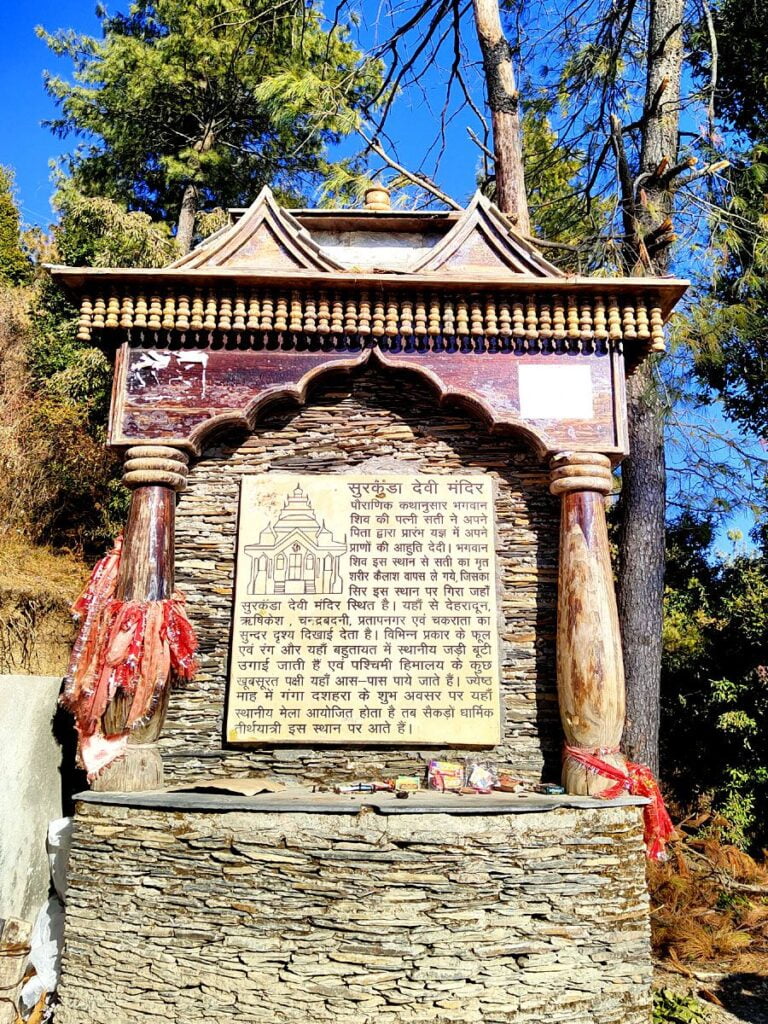Surkanda Devi Temple
The Surkanda Devi Temple is a Hindu temple dedicated to the goddess Sati, wife of the god Shiva. It is located near the hill station of Dhanaulti in the Tehri Garhwal district of Uttarakhand, India. The temple is perched on a hilltop at an altitude of about 2,756 meters (9,042 feet) and offers stunning views of the surrounding Himalayas.

Contents
- 1 Surkanda Devi Temple History:
- 2 Legend of Surkanda Devi Temple:
- 3 Significance of Surkanda Devi Temple:
- 4 Myths of Surkanda Devi Temple:
- 5 Specialty of Surkanda Devi Temple:
- 6 Surkanda Devi Temple Timing and Rituals:
- 7 Places to visit near Surkanda Devi Temple:
- 8 FAQ:
- 8.0.1 Q: Where is Surkanda Devi Temple located?
- 8.0.2 Q: How to reach Surkanda Devi Temple?
- 8.0.3 Q: What is the best time to visit Surkanda Devi Temple?
- 8.0.4 Q: What are the timings of Surkanda Devi Temple?
- 8.0.5 Q: What are the facilities available at Surkanda Devi Temple?
- 8.0.6 Q: What are the things to do near Surkanda Devi Temple?
- 8.0.7 Q: What are the festivals celebrated at Surkanda Devi Temple?
- 8.0.8 Q: What are the legends associated with Surkanda Devi Temple?
- 8.0.9 Q: What are the miracles associated with Surkanda Devi Temple?
- 8.0.10 Q: What are the things to keep in mind while visiting Surkanda Devi Temple?
- 9 How to reach Surkanda Devi Temple:
- 10 Google Maps:
Surkanda Devi Temple History:
Mythological Origins:
The most prevalent story traces the temple’s origin to the legend of Sati, wife of Lord Shiva. Enraged by her father’s disrespect towards Shiva, Sati immolated herself. Grief-stricken, Shiva carried her body across the land, and at the present location of the temple, her head fell. This spot, named “Sirkandi” (meaning “head” in Hindi), evolved into “Surkanda” over time. The temple became a sacred site dedicated to Goddess Shakti, often identified as a manifestation of Parvati, Shiva’s consort.
Shakti Peetha Significance:
According to Hindu belief, Sati’s body parts fell at various locations after her immolation, creating 51 sacred sites known as Shakti Peethas. Surkanda Devi Temple finds recognition as one of these significant pilgrimage destinations. Devotees believe the temple houses the divine energy of the Goddess, seeking blessings for spiritual growth, protection, and fulfillment of desires.
Historical Aspects:
While the exact date of the temple’s construction remains unclear, some historians estimate it dates back to the 8th or 9th century AD. The architectural style reflects influences from the Katyuri and Garhwal dynasties, suggesting potential renovations and additions over time.
Present-Day Significance:
Today, Surkanda Devi Temple stands as a prominent pilgrimage site in Uttarakhand, attracting devotees throughout the year. The annual Ganga Dussehra festival draws large crowds, especially during May-June. Visitors are captivated not only by the temple’s spiritual significance but also by its breathtaking panoramic views of the Himalayas and surrounding valleys.
Read More>> Triyuginarayan Temple: Journey to the Eternal Flame

Legend of Surkanda Devi Temple:
The Surkanda Devi Temple in Uttarakhand holds a powerful place in Hindu mythology, with two prominent legends associated with it:
1. The Legend of Sati:
This widely known legend revolves around Sati, the first wife of Lord Shiva. According to the story, Sati’s father Daksha held a grand sacrificial ceremony (yagna) but deliberately excluded Shiva and Sati. Feeling insulted, Sati immolated herself in the sacred fire. Overcome with grief, Shiva embarked on a destructive Tandava dance while carrying Sati’s body. To stop the destruction, Lord Vishnu used his Sudarshana Chakra to dismember Sati’s body, with pieces falling at various locations across the subcontinent. These sites became revered Shakti Peethas, each dedicated to a specific aspect of the Goddess.
The legend states that Sati’s head fell at the location where the Surkanda Devi Temple now stands. The name “Surkanda” itself is derived from “Sir” (head) and “Khanda” (part), signifying the significance of the fallen body part.
2. The Legend of Durga and Mahishasura:
This lesser-known legend tells the story of Goddess Durga’s battle against the demon Mahishasura. During the fierce fight, parts of the demon’s body were scattered across different regions, each becoming a sacred site. According to this legend, Mahishasura’s head fell at the place where the Surkanda Devi Temple is located, further adding to its sacredness.
While the origin story may differ, both legends emphasize the Surkanda Devi Temple’s importance as a Shakti Peeth, a powerful symbol of the Divine Feminine. Devotees, particularly women, seek blessings from the Goddess for well-being, prosperity, and spiritual growth.
Read More>> Panch Kedar Yatra: Ultimate Travel Guide to 5 Divine Shiv Temples

Significance of Surkanda Devi Temple:
Religious Significance:
- Shakti Peeth: It is one of the 51 sacred Shakti Peethas scattered across India, each representing a body part of Sati, the consort of Lord Shiva. Legend states that her head fell at the site where the temple now stands, hence the name “Surkanda” (Head + Fallen).
- Goddess Parvati: The temple is dedicated to Goddess Parvati, an incarnation of Sati and revered for her power, wisdom, and protective nature. Devotees visit seeking blessings for prosperity, protection, and fulfillment of wishes.
- Pilgrimage Site: The temple attracts pilgrims, particularly during Navratri and Ganga Dussehra festivals, who undertake the challenging trek as a form of devotion and spiritual journey.
Historical Significance:
- Ancient Origins: While evidence is limited, the temple’s origins possibly date back centuries, with mentions even in 18th-century travelogues. Its historical significance lies in its connection to local folklore and the evolution of religious practices.
- Architectural Heritage: The temple’s architecture showcases traditional style with intricate carvings and motifs. While the exact construction period is unknown, its presence adds to the historical value of the region.
Cultural Significance:
- Local Traditions: The temple is deeply integrated into the local culture and traditions of Uttarakhand. Rituals, offerings, and festivals held here provide a window into the region’s beliefs and practices.
- Symbol of Shakti: The temple represents the feminine divine power (Shakti) and empowers women seeking blessings for well-being and prosperity. It holds cultural significance for its association with women’s strength and resilience.
Read More>> Badrinath Temple | Badrinarayan Temple

Myths of Surkanda Devi Temple:
- The Wish-Granting Goddess: Another myth associated with the temple is that Surkanda Devi grants wishes to her devotees. Many pilgrims visit the temple to pray for blessings related to health, wealth, and prosperity.
- The Miraculous Idol: The idol of Surkanda Devi enshrined in the temple is believed to be self-manifested (Swayambhu). Legend has it that the idol was discovered by a shepherd who was guided by a divine voice.
- The Healing Powers of the Spring: There is a natural spring located near the temple that is believed to have healing powers. Devotees often collect water from this spring and use it for bathing or drinking, believing it will cure ailments and bring good health.
- The Ghost of Sati: Some believe that the ghost of Sati still roams the temple grounds, especially during the night. This belief is often used to explain strange occurrences or unexplained phenomena that happen around the temple.
Read More>> Panchsagar Shaktipeeth Uttarakhand
Specialty of Surkanda Devi Temple:
1. One of the 51 Shakti Peethas:
The temple is one of the 51 Shakti Peethas, considered sacred sites in Shaktism tradition. These sites are believed to represent the body parts of Sati, the consort of Lord Shiva, that fell across the Indian subcontinent. Surkanda Devi is specifically said to enshrine Sati’s head, giving the temple its significance.
2. Picturesque Location:
Nestled amidst the scenic beauty of the Garhwal Himalayas, the temple offers breathtaking views of the surrounding landscape, including the snow-capped peaks and lush valleys. The trek to the temple itself is considered a spiritual journey, providing an opportunity to connect with nature and enjoy the serenity of the mountains.
3. Architectural Charm:
While the temple structure itself is relatively simple, it possesses a certain charm with its colorful facade and traditional design elements. The interiors house various idols and images depicting Hindu deities, adding to the spiritual ambiance.
4. Religious Significance:
The temple attracts a large number of devotees throughout the year, especially during festivals like Ganga Dussehra and Navratri. Devotees seek blessings from the goddess for various reasons, including good health, prosperity, and spiritual well-being.
5. Adventure and Experience:
Reaching the temple involves a short but scenic trek, making it a popular destination for adventure seekers and nature enthusiasts. The trek offers moderate challenges and rewards with stunning views and a sense of accomplishment upon reaching the temple.
Read More>> Kedarnath Temple: Where Faith Meets Jyotirling & Char Dham Yatra

Surkanda Devi Temple Timing and Rituals:
Timings:
The temple is open from 6:00 AM to 7:00 PM on all days of the week.
Rituals:
- The main rituals performed at the Surkanda Devi Temple are:
- Mangal Aarti: This is performed every morning at sunrise and evening at sunset. Devotees can participate in this ritual by offering prayers and singing devotional songs.
- Chundi Yatra: This is a special ritual performed during the Navratri festival. Devotees carry a
chunri(a piece of cloth) on their head and walk barefoot from Kaddukhal to the temple. - Parikrama: Devotees can also perform a
parikrama(circumambulation) of the temple complex. This is believed to bring good luck and blessings.
Read More>> Char Dham Yatra – A Complete Guide to Spiritual Destination
Places to visit near Surkanda Devi Temple:
- Tehri Dam: Tehri Dam is one of the largest dams in India and offers breathtaking views of the surrounding mountains and the Tehri Lake. It’s about 50 kilometers from Surkanda Devi Temple.
- Dhanaulti: Dhanaulti is a serene hill station situated about 24 kilometers from Surkanda Devi Temple. It is known for its lush greenery, beautiful landscapes, and peaceful atmosphere.
- Chamba: Chamba is a picturesque town located approximately 60 kilometers away from Surkanda Devi Temple. It is known for its ancient temples, stunning views of the Himalayas, and a tranquil environment.
- Mussoorie: Mussoorie, also known as the “Queen of Hills,” is a popular hill station around 80 kilometers from Surkanda Devi Temple. The town is famous for its colonial architecture, pleasant weather, and vibrant markets.
- New Tehri: New Tehri is the modern town that was established after the old Tehri town was submerged due to the construction of the Tehri Dam. It offers a glimpse into the history of the region and provides various water sports activities at the Tehri Lake.
- Kanatal: Kanatal is a charming village located around 38 kilometers from Surkanda Devi Temple. It is known for its apple orchards, dense forests, and panoramic views of the snow-capped Himalayas.
- Chandrabadni Temple: Another sacred site nearby is the Chandrabadni Temple, dedicated to Goddess Chandrabadni. It is about 10 kilometers from Surkanda Devi Temple and offers stunning views of the surrounding mountains.
- Nag Tibba: If you enjoy trekking, Nag Tibba is a great option. It is the highest peak in the Lesser Himalayas and offers panoramic views of the snow-capped peaks.
FAQ:
Q: Where is Surkanda Devi Temple located?
A: Surkanda Devi Temple is located in the Tehri Garhwal district of Uttarakhand, India. It is situated at an altitude of 2,750 meters above sea level and is dedicated to Goddess Parvati. The temple is located near Dhanaulti, which is about 28 km from Mussoorie.
Q: How to reach Surkanda Devi Temple?
A: There are two ways to reach Surkanda Devi Temple:
- By road: The temple is well connected by road from Mussoorie and Dehradun. You can hire a taxi or take a bus from either city. The journey from Mussoorie takes about an hour and a half, while the journey from Dehradun takes about two hours.
- By trek: The temple can also be reached by a trek from Kaddukhal, which is about 6 km from Dhanaulti. The trek is about 2 km long and takes about an hour to complete.
Q: What is the best time to visit Surkanda Devi Temple?
A: The best time to visit Surkanda Devi Temple is during the summer months (April to June) and the winter months (October to February). The weather is pleasant during these months and the temple is less crowded.
Q: What are the timings of Surkanda Devi Temple?
A: The temple is open from 6:00 AM to 12:00 PM and from 2:00 PM to 8:00 PM.
Q: What are the facilities available at Surkanda Devi Temple?
A: There are a few facilities available at Surkanda Devi Temple, including:
- A cloakroom
- A shoe rack
- A prasad shop
- A restaurant
- A toilet
Q: What are the things to do near Surkanda Devi Temple?
A: There are a few things to do near Surkanda Devi Temple, including:
- Trekking
- Camping
- Sightseeing
- Visiting the nearby temples
Q: What are the festivals celebrated at Surkanda Devi Temple?
A: The following festivals are celebrated at Surkanda Devi Temple:
- Navratri
- Dussehra
- Diwali
- Mahashivratri
Q: What are the legends associated with Surkanda Devi Temple?
A: There are a few legends associated with Surkanda Devi Temple, including:
- The legend of Sati
- The legend of Shiva
- The legend of the Pandavas
Q: What are the miracles associated with Surkanda Devi Temple?
A: There are a few miracles associated with Surkanda Devi Temple, including:
- The healing of the sick
- The fulfillment of wishes
- The protection from evil
Q: What are the things to keep in mind while visiting Surkanda Devi Temple?
A: Here are a few things to keep in mind while visiting Surkanda Devi Temple:
- Dress modestly
- Remove your shoes before entering the temple
- Do not touch the idols
- Do not offer alcohol or meat to the goddess
- Be respectful of other pilgrims
How to reach Surkanda Devi Temple:
- By Air: The nearest airport to Surkanda Devi Temple is Jolly Grant Airport in Dehradun, which is approximately 92 kilometers away. From the airport, you can hire a taxi or take a bus to reach the temple.
- By Train: The nearest railway station is Dehradun Railway Station, which is about 84 kilometers away from the temple. From the railway station, you can hire a taxi or take a bus to reach the temple.
- By Road:
- From Dehradun:
- Surkanda Devi Temple is well-connected by road. You can take a bus or hire a taxi from Dehradun to reach Kaddukhal.
- From Kaddukhal, the temple is around 2 kilometers away. You can hire a local taxi or trek to the temple.
- From Rishikesh/Haridwar:
- You can take a bus or hire a taxi from Rishikesh or Haridwar to reach Chamba.
- From Chamba, you can further hire a taxi or take a local bus to reach Kaddukhal.
- Finally, from Kaddukhal, you can either hire a local taxi or trek to Surkanda Devi Temple.
- From Dehradun:
